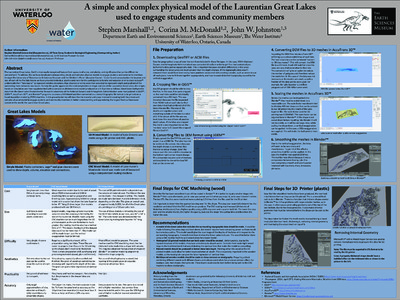| dc.contributor.author | Marshall, Stephen | |
| dc.contributor.author | McDonald, Corina | |
| dc.contributor.author | Johnston, John | |
| dc.date.accessioned | 2020-04-24 15:18:31 (GMT) | |
| dc.date.available | 2020-04-24 15:18:31 (GMT) | |
| dc.date.issued | 2015-05-19 | |
| dc.identifier.uri | http://hdl.handle.net/10012/15785 | |
| dc.description.abstract | The Laurentian Great Lakes, Earth’s most-easily recognized feature from space, is of a size, complexity, and significance that can be difficult to comprehend. To address this we have developed corresponding simple and complex physical models to engage students and community members through The University of Waterloo Earth Sciences Museum and the Children’s Water Education Council. To clarify and conceptualize the location and size of each of the five lake basins we have provided individual plastic containers for the participants to handle and organize prior to stacking Lego™ underneath their “lake basins” to represent relative elevations. Pipe cleaners or string were then provided to represent length and gradient of the connecting rivers between lake basins. To help the public appreciate the real complexities in shape and size of the Laurentian Great Lakes, the simple, hands-on simulation was then supplemented with a complex multidimensional model produced on a 3-D printer as follows. Great Lakes bathymetric data from the Great Lakes Environmental Research Laboratory of the National Oceanic and Atmospheric Administration were manipulated in QGIS™, 3DEM™, AccuTrans 3D™, and Blender™ programs to create a 3-D Model and then converted to a stereolithography file format to be printed on a fused deposition modeling (FDM) machine. In this presentation we will describe the material and steps involved in creating both the simple and complex physical model to engage students and community members in better understanding and appreciating the largest fresh surface-water system in the world, the Laurentian Great Lakes. This was presented as a poster – Marshall, Stephen and McDonald, Corina and Johnston, John, 2015, A simple and complex physical model of the Laurentian Great Lakes used to engage students and community members, The Geological Society of America North-Central Section - 49th Annual Conference, Madison, WI, USA, Abstracts with Program, Vol. 47, No. 5, p.35. Also, 2015 Best Undergraduate Student Poster (during co-op work term at UW with Earth Science Museum) – World Water Day Research Fair & Water Celebration – University of Waterloo Water Institute, and the Laurier Institute for Water Science. | en |
| dc.description.sponsorship | Dr. John Johnston University of Waterloo Starter Grant. | en |
| dc.language.iso | en | en |
| dc.publisher | The Geological Society of America North-Central Section | en |
| dc.subject | Laurentian Great Lakes | en |
| dc.subject | Great Lakes | en |
| dc.subject | fused deposition modeling | en |
| dc.subject | lake basin | en |
| dc.subject | bathymetry | en |
| dc.subject | 3D print | en |
| dc.subject | education | en |
| dc.subject | Great Lakes Environmental Research Laboratory | en |
| dc.subject | National Oceanic and Atmospheric Administration | en |
| dc.subject | Earth Sciences Museum | en |
| dc.subject | Children’s Water Education Council | en |
| dc.subject | physical models | en |
| dc.title | A simple and complex physical model of the Laurentian Great Lakes used to engage students and community members | en |
| dc.type | Conference Poster | en |
| dcterms.bibliographicCitation | Marshall, Stephen and McDonald, Corina and Johnston, John, 2015, A simple and complex physical model of the Laurentian Great Lakes used to engage students and community members, The Geological Society of America North-Central Section - 49th Annual Conference, Madison, WI, USA, Abstracts with Program, Vol. 47, No. 5, p.35. | en |
| uws.contributor.affiliation1 | Faculty of Science | en |
| uws.contributor.affiliation2 | Earth and Environmental Sciences | en |
| uws.typeOfResource | Text | en |
| uws.peerReviewStatus | Unreviewed | en |
| uws.scholarLevel | Other | en |

